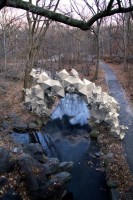ARANDA\LASCH
阿兰达\拉希
アランダ\ラッシュ
source: thecreatorsproject
Crystallography, molecular structures, cosmology—three things that aren’t usually associated with designing a chair or a house, but these scientific subjects are what architects and designers Aranda\Lasch mine to create their modular designs that emulate the infinite.
It’s an approach that favors systems over principles, building structures that can replicate in an endless amount of ways like a living system, growing into a variety of possibilities to create abstract forms that challenge our notions of what an object has to look like. Which is why they look to disciplines like crystallography for inspiration and guidance.
While crystallography might seem like it’s pretty far removed from how to design a chair or a building, it’s actually informing how designers look at the products we use every day—computer chips, cell phone batteries—and is, as Benjamin Aranda says “driving an invention in material culture.”These ideas might not be so familiar to the average person, but for designers they’re shaping how they think about the processes and structures that go into creating an object.
Christopher Lasch defines the companies design ethic as: “For us design is about putting in place a process from which you can guarantee surprises.” Surprises that are built using algorithms and formed from fractal anatomies, allowing the duo to find the endless in an object—whether that’s creating a bridge from octahedrons or a crystalline stage set for Yeasayer. As Benjamin Aranda explains: “Our understanding of modularity is something that’s not quite obvious or fixed, something that can be a tool for finding infinite variation.”
.
.
.
.
.
.
source: artlog
At the design and architecture firm Aranda/Lasch, repetition is not redundant, it is a gateway to infinite possibilities. Through their study of crystals and implementation of computer algorithms, Benjamin Aranda and Chris Lasch apply the rules of solid-state matter to architecture.
Looking to modularity for inspiration, they sample structures as small as a molecule to constructs of cosmological size. Their designs represent a divergent path in sustainable architecture: rather than plant growth and curves, think of crystal growth and hard edges.


